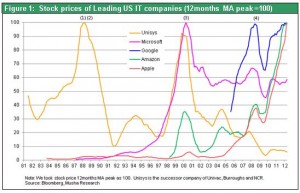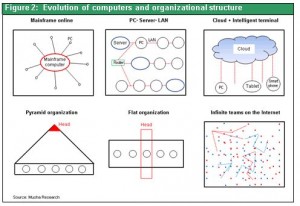Shockwaves from the emergence of cloud computing and intelligent terminals
Cloud computing, smartphones, social networking services and other innovative ideas in recent years are fueling a new industrial revolution. The silhouette of a major shift in corporate business models has started to appear. Two decades ago, the widespread use of dispersed data processing with personal computers and servers sparked the business process reengineering (BPR) revolution. The result was a dramatic shift in how companies operated and in their cost structures. Now, the emergence of cloud computing may lead to changes of an even greater magnitude.
A new era has started because of the advent of cloud computing along with the sharp drop in the cost of communications. In this era, companies can operate by entrusting database and data processing operations to external service providers. A company’s internal operations require only a terminal. Moreover, these terminals are intelligent devices like smartphones, which fit in the palm of your hand, tablets and personal computers. This framework that smartphones have created for consumers is at last starting to become the nucleus of systems used by companies. Moving services off-site makes it possible for companies to perform enormous processes with ease and at a low cost. Just like using the magic powers of Aladdin’s lamp, companies can receive the best possible solutions from external sources in a unified manner even though they may have nothing themselves. Recipients of these solutions require nothing more than an objective and motivation. The closed-in IT approach of previous years in which companies internalized everything is losing its competitive edge as the capabilities of outsourced services increase.
High-tech flagship companies are shifting their stances one after another
Figure 1 shows the stock prices (peak=100) of the leading companies in the high-tech sector, which is the most important industry in the United States. Over the past three to four decades, it is surprising to see how often the flagship companies of this sector have come and gone. Until the mid-80s, the premier high-tech companies were mainframe computer suppliers like IBM and Unisys. In the 1990s, Intel and Microsoft became the flagship companies as the world advanced to the age of dispersed processing that relies on personal computers and servers. In today’s age of cloud computing, smartphones and the Internet, the biggest names are Apple, Google and Amazon. However, whereas in the United States, a high-tech flagship company replacement cycle of slightly more than 10 years is still going on, Japan has seen no changes in its leading high-tech companies for decades.
Figure 1: Stock prices of Leading US IT companies (12months MA peak =100)

Significantly, today’s leading companies were founded and established their bases of operations as the IT bubble grew during the late 1990s and in 2000. In financial terms, the IT bubble was regarded as out-of-control alchemy. But for emerging companies, this bubble was a vital source of funds. Therefore, rather than being merely a financial phenomenon, the IT boom was also a cradle for entrepreneurs.
The significance of this replacement of high-tech flagship companies is not limited to the high-tech industry. New core high-tech companies fundamentally altered the nervous system of economic society, bringing about momentous structural changes in society and companies. Dramatic changes have occurred in the framework of information society due to shifts in the composition of computer systems.
(1) The 1970s were the age of centralized (batch) data processing using mainframe computers.
At the forefront of this era were the so-called BUNCHI companies: Burroughs, Unisys, NCR, Control Data, Honeywell and IBM.
(2) The 1980s were the age of online data processing using mainframe computers.
The biggest names were IBM along with DEC and other makers of mini-computers.
(3) The 1990s were the age of dispersed data processing using personal computers and servers (intelligent terminals).
Intel, Microsoft and Sun Microsystems were the leaders.
(4) The current decade is beginning of the age of cloud computing, in which the “cloud” is used to provide all types of data processing and databases to intelligent terminals.
The flagship companies are Google, Amazon and Apple.
Advances from one age to another have been accompanied by a dramatic change in the organization of U.S. industrial activity and business models that was backed by progress involving the platform of the information society. For example, there was a BPR revolution during the era of the 1990s that produced a completely flat organizational structure at U.S. companies. This structure subsequently became the platform for the Internet age. Therefore, serving as the primary force behind the transformation of industrial activity is not the only role of cloud computing, which again draws on the intelligence of terminals and then hides it in the cloud. Cloud computing also has the potential of turning upside-down the organization of industries and eventually the business models of all companies.
Figure 2 shows organizational changes and the evolution of how computers are used. The fundamental shape of an organization was a pyramid prior to the age of BPR of 20 years ago. The big change to a flat structure created an enormous shock. Now, the transition to cloud computing means that 6 billion people around the world who have intelligent terminals can communicate freely with one another. By allowing work to be performed jointly, this advance may lead to the following change in the fundamental nature of interpersonal relationships:
Pyramid organizations ⇒ Flat organizations ⇒ (abandon organizations) Unrestricted teams that use networks
Figure 2: Evolution of computers and organizational structure

Cloud computing has produced one more shock: the rapid advancement of knowledge by using high-speed feedback. Even empty-handed start-ups have the potential of making judgments and decisions that surpass human wisdom. This is possible by establishing a virtuous cycle driven by a continuous high-speed dialogue with the most advanced information and intelligence of external sources. As a result, we are in an age where even start-up companies with nothing but objectives and motivation can become successful.
The superiority of the U.S. is becoming even greater
In this new age, the most decisive factor is the ability to control the black box in the cloud. Inside this black box are all of the world’s knowledge and wisdom. In this respect, the United States is obviously far ahead of other countries. By constantly evolving, U.S. industries and companies are beginning to prosper in this new style of economy. Record earnings at U.S. companies along with measures to cut costs while using less labor and less capital are probably closely related to the new cloud computing framework. To repeat my earlier point, I want to stress that the current popular belief that “the atmosphere of demanding financial capitalism and the easing of excessive financing for the cause of surplus labor (rising unemployment) and surplus capital (record-low interest rates)” is nothing more than a one-sided view.
 Significantly, today’s leading companies were founded and established their bases of operations as the IT bubble grew during the late 1990s and in 2000. In financial terms, the IT bubble was regarded as out-of-control alchemy. But for emerging companies, this bubble was a vital source of funds. Therefore, rather than being merely a financial phenomenon, the IT boom was also a cradle for entrepreneurs.
The significance of this replacement of high-tech flagship companies is not limited to the high-tech industry. New core high-tech companies fundamentally altered the nervous system of economic society, bringing about momentous structural changes in society and companies. Dramatic changes have occurred in the framework of information society due to shifts in the composition of computer systems.
Significantly, today’s leading companies were founded and established their bases of operations as the IT bubble grew during the late 1990s and in 2000. In financial terms, the IT bubble was regarded as out-of-control alchemy. But for emerging companies, this bubble was a vital source of funds. Therefore, rather than being merely a financial phenomenon, the IT boom was also a cradle for entrepreneurs.
The significance of this replacement of high-tech flagship companies is not limited to the high-tech industry. New core high-tech companies fundamentally altered the nervous system of economic society, bringing about momentous structural changes in society and companies. Dramatic changes have occurred in the framework of information society due to shifts in the composition of computer systems.
 Cloud computing has produced one more shock: the rapid advancement of knowledge by using high-speed feedback. Even empty-handed start-ups have the potential of making judgments and decisions that surpass human wisdom. This is possible by establishing a virtuous cycle driven by a continuous high-speed dialogue with the most advanced information and intelligence of external sources. As a result, we are in an age where even start-up companies with nothing but objectives and motivation can become successful.
Cloud computing has produced one more shock: the rapid advancement of knowledge by using high-speed feedback. Even empty-handed start-ups have the potential of making judgments and decisions that surpass human wisdom. This is possible by establishing a virtuous cycle driven by a continuous high-speed dialogue with the most advanced information and intelligence of external sources. As a result, we are in an age where even start-up companies with nothing but objectives and motivation can become successful.

